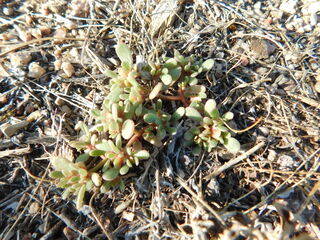Omega-3
Edible Weeds That Are Good for the Body and Brain
Dandelions and purslane pack in antioxidants and omega-3 fatty acids.
Posted May 25, 2021 Reviewed by Chloe Williams
Key points
- Dandelions are antioxidant powerhouses and have anti-inflammatory properties. They are used in a variety of dishes, especially Italian cuisine.
- Purslane was once used as a medicinal herb. The weed is high in vitamins, minerals, dietary fiber and omega-3 essential fatty acids.
- Weeds can interact with medications and cause health problems for some people. It's important to pick weeds from pollution-free areas.
Many health care professionals, myself included, believe that food is our medicine, which is why we must consider nutrition in any discussion about health. The brain is a miraculous part of our body. Much contemporary research proves that brain functioning can be improved at any age and in most circumstances if done in the right way. Proper nutrition is essential for our body, brain, and well-being.
We know now that our gut produces 90 percent of serotonin, the “feel good” substance in our brain, which is much more than the brain produces. That’s why it’s sometimes called “the second brain.” Our gut’s health is also essential for our immune system. A healthy diet is essential for our overall health.
Herbs have been part of humans' diets for centuries. Most herbs are weeds, which is the source of their potency. They can survive in all kinds of soil and air temperatures and can spread rapidly, taking over your garden if you’re not careful. Peppermint is one of the aggressive types and best grown in a container. Most of the culinary and medicinal herbs are easily grown, care-free and will come back every spring. Some culinary herbs are also medicinal.
In today’s post, I want to put my readers’ attention to two common weeds that are also culinary and medicinal herbs, and what is most important: that they are antioxidant powerhouses.
Dandelions

Dandelions, those annoying weeds in the middle of your beautiful lawn, are a huge and amazing antioxidant powerhouse. Their anti-inflammatory properties have been known for centuries. They may help cleanse the liver and the kidney. They contain vitamin C, B6, thiamin, riboflavin, calcium, iron, potassium, magnesium, folate, phosphorus, zinc, and copper.
Dandelions are used in a variety of dishes, especially in Italian cuisine. You can make delicious dandelion soup, but you’ll get the most benefit by using them in salads. If you don’t like the taste, since it can be bitter, then put dandelions into a smoothie with other greens and fruits and you won’t even notice the taste. Please remember that the bitterer they are, the better they are for you, since the bitterest ones have the most antioxidant power and health benefits.
Dandelions grow everywhere, so they’re easy to find. However, don’t use the ones from your lawn if you’re using any pesticides and/or nonorganic lawn fertilizer. Also, don’t pick them from high traffic, polluted areas or from areas that can be contaminated by your four-legged friends. The best place to pick them is from an area that’s reasonably pollution-free or to let them grow in one part of your garden or yard. You can use the whole plant in smoothies or use the leaves in a salad. You can also buy dandelion leaves in health food stores, but the wild-grown ones usually have more antioxidant potency, especially in early spring before they start flowering. Just pick the whole green rosette of young leaves with the root, clean the root and leaves and put the whole plant into your smoothie.
One more important thing: If you have allergies to plants or weeds or you’re taking medications, please talk to your doctor before eating dandelions, since they may cause some allergies and interact with certain medications.
Wild Purslane

Not everybody knows that purslane, an annoying weed that pops out in abundance in fields, gardens, walls, and sidewalk cracks, is packed with nutrients. Purslane is a perennial succulent that grows close to the ground. It has paddle-shaped green leaves, pink or red stems, and tiny yellow flowers. The leaves, tender stems, and flowers can be eaten. Purslane has a slightly sour and salty, piquant taste. Its seeds are used in herbal drinks. Purslane was used in the ancient world as a medicinal herb and is still used for some inflammatory and other medical conditions. Because it’s packed with omega-3 fatty acids, it may also reduce the risk of heart disease.
Purslane is cultivated for culinary purposes and used in African, Middle Eastern, and Mexican cuisine. It’s low in fat and calories, but rich in dietary fiber, vitamins, and minerals. It contains more omega-3 essential fatty acids (alpha-linolenic acid) than any other leafy plant. Therefore, it can be a good source of omega-3 fatty acid for vegans, who prefer not to take the acid that comes from fish. Purslane is high in vitamin A, C, E, B-complex, iron, magnesium, calcium, beta-carotene, and more (Uddin, K. et al. 2014).
However, it also contains oxalic acid. For sensitive people, diets high in oxalic acid (also present in spinach, rhubarb, and peanuts), have been linked to an increased risk of kidney stones. If you have a family history of kidney stones or have the disease yourself, you may need to avoid eating plants high in oxalic acid. For the rest of us, purslane can be used in smoothies, soups, salads, stir-fries, etc. It can also be added to fish, pork, eggs, or whatever you like. You can even make a purslane pesto. If you don’t like the taste of purslane but still want to use it for its many health benefits, then put it in your smoothie. You won’t taste it much or may not taste it at all when mixed with many other ingredients.
Unlike the leaves of wild dandelions, which wilt fast, purslane can be kept in a fridge for three to four days. It also freezes very well and can be added to your soups or smoothies during winter. You can also dry purslane for winter use if you wish. I hope I’ve made you want to try this versatile plant, which is easy to get since it’s actually a common weed.
P.S. Part of today’s post is also in my book, How My Brain Works: A Guide to Understanding It Better and Keeping It Healthy.
Copyright by Dr. Barbara Koltuska-Haskin
References
Uddin, Kamal, et al. "Purslane Weed (Portulaca oleracea): A prospective Plant Source of Nutrition, Omega-3 Fatty Acid, and Antioxidant Attributes." Scientific World Journal (2014)




